IAC News
IAC News No.32, Jun 2015
International Activities Center Jun. 1, 2015 IAC News No.32 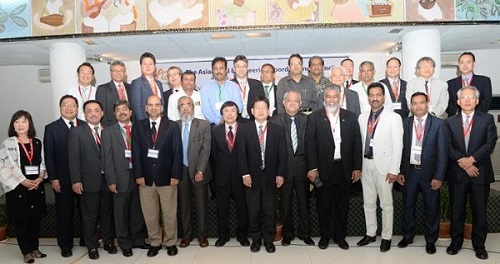
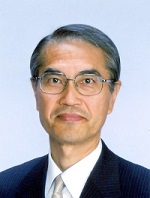
Masahiko ISOBE
JSCE President
JSCE’s Contribution to the 3rd UN World Conference on Disaster Risk Reduction
The Third UN World Conference on Disaster Risk Reduction (The 3rd UN WCDRR) was held in Sendai, Miyagi, from March 14 to 18. The United Nation General Assembly designated the 1990s as the International Decade for Natural Disaster Reduction (IDNDR) and held as part of the review of IDNDR the first UN WCDRR in Yokohama in 1994, the second one in Kobe in 2005, and the third one on the above dates and place. Japan, the natural disaster-prone country, that has made every effort to minimize disaster risks hosted past UN WCDRR. In the third conference, the post-Hyogo Framework for Action 2005-2015 was adopted as the Sendai Framework for Disaster Risk Reduction 2015-2030 and Sendai Declaration.
As part of the public forms of the 3rd UN WCDRR, JSCE held on March 16 the forum “That has been done by the Japanese Civil Engineers since Mar. 11, 2011” under the leadership of Prof. Akira Mano of JSCE Tohoku Chapter, the chairman of the Joint Academic Research Group for the Great East Japan Earthquake, JSCE. That forum discussed the post-disaster recovery and reconstruction efforts made by several organizations and groups, earthquake-related wastes and debris managements in detail, and then a training program on disaster risk management. Moreover, it introduced the 105 organizations and groups which made significant contribution to processing large amounts of earthquake-related waste and debris within the fixed timeframe. The JSCE President recognized them for their great efforts and works with an appreciation certificate in front of the audience. JSCE had never given appreciation and recognition to such a large number of organizations/groups at one time until then; in other words, because of its unique nature being a public interest incorporated association, JSCE could cite and appreciate several those who worked for public interest.
Prior to the above forum, the public form “Towards Mitigating Loss Caused by Mega-Disasters” took place on March 15, co-hosted by Ministry of Land, Infrastructure, Transport and Tourism (MLIT) and JSCE. Dr. Han Seong-Soo of UN Special Envoy for Disaster Risk Reduction and Water and Prof. Yoshiaki Kawata of Kansai University delivered keynote speeches, followed by the presentations made by representatives from five countries, Japan, the Philippines, Turkey, the United States, and the Netherlands. The JSCE President worked with these speakers as a coordinator. He moreover participated as a panelist in the Working Session on “Underlying Risk Factors” on March 16. In all the above meetings, he delivered a clear and consistent message: it is possible to be adopted widely in the world the two-level disaster management concept that combine “hard” (structural) toward comparatively frequent hazards (Level 1) and “soft” (non-structural) measures toward maximum level hazards (Level 2) in order to reduce/mitigate natural disaster risks and to protect human life and property from all potential hazards.
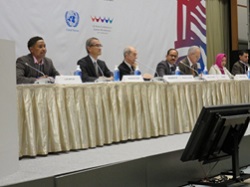
Prof. Isobe with other panelists at the Working Session
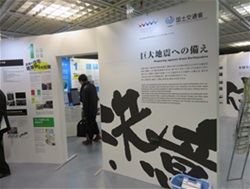
MLIT’s disaster-reduction-themed exhibition
Report on Asian Civil Engineering Coordinating Council (ACECC) 28th Executive Committee Meeting in Dhaka
JSCE was approved to be the hostof the 8th Civil Engineering Conference in Asian Region (CECAR 8) in 2019
Asian Civil Engineering Coordinating Council (ACECC) 28th Executive Committee Meeting (ECM) was held in Dhaka, Bangladesh, from March 27 to March 29, 2015. The major activities of the ACECC are described on pp. 128-129 of the May issue of the JSCE Journal.
Japan’s proposals, reports, etc., chiefly regarded the following two items:
1)Presentation of a bid to host the 8th Civil Engineering Conference in the Asian Region (CECAR 8) in Japan
2)Proposal to set up a new JSCE-led Technical Committee (TC)
The CECAR 8 is scheduled for 2019. In 2020, Tokyo will host the Olympic and Paralympic Games. This will be a great time for CECAR’s participants from Japan and overseas to inspect the progress of the preparations immediately before the games. Moreover, 2019 will mark eight years since the Great East Japan Earthquake, and we believe that it will be meaningful to show other Asian countries how resilient Japan has become.
Mr. Noriaki Hirose, the JSCE president-elect, began the presentation with a speech. Mr. Kusakabe, ACECC representative for JSCE, laid out Japan’s vision of the CECAR. The presentation stressed that, because the ACECC is a unique organization that cooperates with the decision-makers and financial institutions in each country to improve Asia’s social infrastructure, the CECAR should be a unique international conference that encourages the members to communicate and share that vision. To realize this vision, JSCE promised that industry, government, and academia will work together to establish an implementation system and draw up programs that serve a broad range of participants in different positions and across different generations. This message was accepted and JSCE was approved to be the host of the CECAR 8 in 2019.
The JSCE has held three round-table conferences to date and led discussions on initiatives concerning disaster management in the Asian region (RTM on Disaster Management (Asian Board Meeting)). Including the World Conference on Disaster Risk Reduction and the “Japan Bosai (disaster management) Platform,” the initiatives have gained increasing recognition, and Japan is expected to continue to play a central role in the initiatives.
Prof. Eiki Yamaguchi, the JSCE ACECC committee chairman, proposed that these initiatives be carried out as part of the activities of the ACECC’s new TC, and the proposal was approved. At the next meeting, the selection of a new Chair, the activity policy, etc., will be reported.
The 29th ECM is scheduled for October 2015 in Gunsan, Republic of Korea.
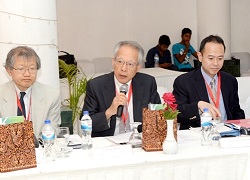
Mr. Hirose(center), president-elect, opens the presentation with a speech
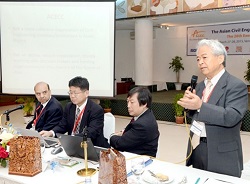
Mr. Kusakabe(right), the ACECC's Japan representative, makes a presentation at the 8th CECAR
【ACECC Commitee Mr. Nakano】
2014 PICE-JSCE Joint Seminar Seminar on Field Surveys, Analysis and Mitigation Strategies for Typhoons and other Coastal Hazards in the Philippines and Japan
Coastal Engineering Committee of Japan Society of Civil Engineers (JSCE) and Philippine Institute of Civil Engineers (PICE) conducted the PICE-JSCE joint survey for severe storm surge disaster caused by 2013 Typhoon Haiyan. Through the survey and following analysis, we found various characteristics of this catastrophic disaster such as: (i) disaster levels vary locally along the coast; (ii) besides inundation due to storm surge, storm waves had significant impact on various area such as the east coast of Eastern Samar; (iii) combination of storm surge and stormy waves amplified the severe coastal disaster around west coast of San Pedro bay; (iv) while the damaged area has frequent attacks of typhoons, the area had not suffered such catastrophic storm surge disasters before Haiyan because of geographical characteristics of the bay; (v) since the disaster caused by Haiyan was the “first catastrophic event” for most of residents, they did not evacuate even though they recognized the warnings before the disaster.
Following the successful Joint Survey and the following various analysis, this Joint Seminar was held on November 28th, 2014 at Quezon City, the Philippines. The seminar had fourteen speakers, the seven from JSCE and the other seven from PICE, and presented various topics such as: (i) wrap ups and important findings of the joint survey results; (ii) physical mechanisms of the disaster based on numerical analysis and experiments; (iii) ongoing and future recovery plans after Haiyan; (iv) examples of coastal disasters and coastal protections in Japan; and (v) future scenarios and corresponding mitigation and adaptation strategies. Table-1 shows the program of the all-day-seminar. The seminar had 84 participants including members of JSCE and PICE and especially many engineers from DPWH, Department of Public Works and Highways, who took key roles in the recovery process of damaged area due to Haiyan. After the presentations, all the participants had discussions about the future tasks toward coastal protection and mitigation strategies on both countries and possible collaborative research and works between JSCE and PICE. Part of discussions and presentations will also be published as several journal papers for Special Issue of Coastal Engineering Journal.
2014 PICE-JSCE Joint Seminar >>> Program Download
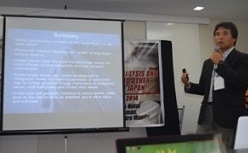
Prof. Yoshimitsu Tajima delivers a presentation
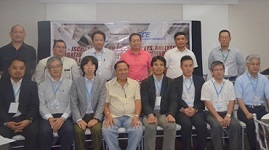
Photo 2 Group photo of the 2014 PICE-JSCE Joint Seminar Speakers
【Prof. Yoshimitsu Tajima, JSCE Coastal Engineering Committee】
What's Happening
- 2015/6/12-13 The Institution of Engineers, Pakistan’s Annual Convention & Civil Engineering Congress (Karachi, Pakistan)
- 2015/6/18-20 2015 MACE Annual Meeting (Ulaanbaatar, Mongolia)
- 2015/7/8-10 EIT Civil Engineering Meeting (Pattaya, Thailand)
Updates
- The summary of feature articles in the JSCE Magazine is available on the JSCE website.
http://www.jsce-int.org/pub/magazine - Concrete Committee International Newsletter No. 41
http://www.jsce.or.jp/committee/concrete/e/newsletter/Newsletter.htm - Journal of JSCE
The Journal of JSCE is the collection of research papers which can be viewed on the JSCE website.
https://www.jstage.jst.go.jp/browse/journalofjsce - JSCE 100th Anniversary Postal Stamp was released in September, 2014.
http://jsce100.com/node/250 (Japanese Only) - European Council of Civil Engineers (ECCE) has released the 2nd
book in ECCE Book Project, ”Footbridges-Small is beautiful.” 17 footbridges are contributed from JSCE:
http://www.ecceengineers.eu/
IAC News Subscription
The IAC News is one of the communication tools to share information and ideas with the members. We would like to invite you, your friends and colleagues to join the communication and to subscribe the IAC News. Please register online: (http://www.jsce-int.org/pub/registration/non-international_students). We look forward to meeting you.
Editor's postscript
The other day, I took my kids to the park nearby after a long interval. Before I stopped them, they took off their shoes and ran to the waterside. Still in May…I think I still have time before summer comes, but it seems that summer has already begun for them. Enjoy your summer guys! (S.O.)
